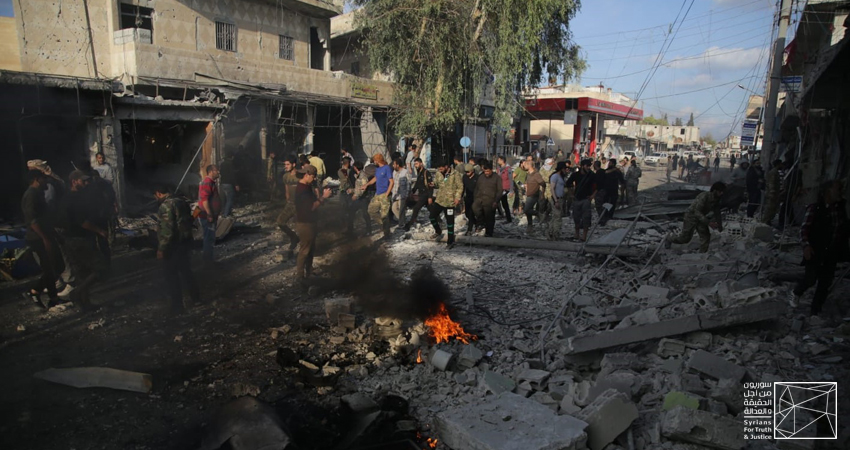The city of Tell Abiad and the town of Slouk, Raqqa Province, bore witness to no less than a dozen of blasts, in which car and motorcycle bombs were deployed, since the Turkish Army took control of the area during the military operation Peace Spring, launched on October 9, 2019, in which the Syrian Interim Government-affiliated National Army also had a direct role.
Taking place between October 13 and November 23, 2019, the blasts rendered up to 25 persons either dead or injured, both civilians and children included.
In the aftermath of the bombings, the armed opposition groups in control of the area set up checkpoints at the entrances to the city and the town, erecting others on the major streets and near their military headquarters. The armed groups have also blocked the side roads to markets, allowing no vehicles in.
The armed groups arrested a person, suspected for having a part in one of the blasts suffered by the city of Tell Abiad, who was accompanied by a woman and a child, reportedly his family, who were also held captive. Neither the man’s nor the family’s destiny is known yet.
The armed groups, in control of the area, particularly the al-Jabha al-Shamiyah/Levant Front, Filaq al-Majd/Glory Brigade and the Ahrar al-Sharqiya, published tweets on their official Twitter accounts accusing the Syrian Democratic Forces/SDF of perpetuating these blasts. The latter, however, denied responsibility for these incidents in a statement published on its official website on November 3, 2019.
This report is based on interviews conducted by the field researcher of Syrians for Truth and Justice/STJ. In addition to meeting blast survivors, a medical staffer and a military source in the city of Tell Abiad and the town of Slouk, in person, the researcher also monitored the security conditions in the area following the explosions, documenting the names of 19 casualties, out of more than 23 persons who died in the blasts.
It is worth mentioning that both explosions and security chaos in the areas lately taken over by the National Army in Northeastern Syria bear the resemblance of incident that happened and are yet happening in other Turkey-held areas, which late in October suffered a series of consecutive blasts in the city of Afrin and the village of Sharran, as well as the areas of the Euphrates Shield, specifically in the villages of Tell al-Hawa, Nada, Sajo while the last of the blasts hit the city of Azaz on November 25, 2019. STJ is working on a detailed report that is to address dozens of other blasts that shook the area.
1. Blasts and Current Security Conditions in Tell Abiad:
The city of Tell Abiad, which fell to the power of the National Army on October 13, 2019, suffered four explosions of car and motorcycle bombs. Three of these were presumably targeting the military posts of the al-Jabha al-Shamiyah/Levant Front and the Filaq al-Majd/Glory Brigade. The fourth explosion, nonetheless, took place at a popular market on the city’s main street, where no military targets could be found near the attacked site.
STJ’s field researcher monitored the blasts which took place as thus:
1. On November 23, 2019, a car bomb was detonated in the Industrial Area in Tell Abiad City. Reporting the incident, STJ’s field researcher who visited the explosion’s site, said that four persons died, whose names he managed to document, in addition to another who remains unidentified and four injured persons, including children belonging to Issa al-Enaizan’s family. The dead are Majed al-Enaizan, Mohammad al-Awad al-Issa and Mohammad Juma al-Sultan, in addition to a person called Attieh, whose surname was unknown.
STJ’s field researcher added that the explosion’s location is 300 meters far from the headquarters of the National Army-affiliated Third Legion’s command, which is positioned at the building of the city’s Directorate. The blast also happened 1 kilometer away from a checkpoint of the al-Jabha al-Shamiyah/Levant Front, set up at the city’s entrance.
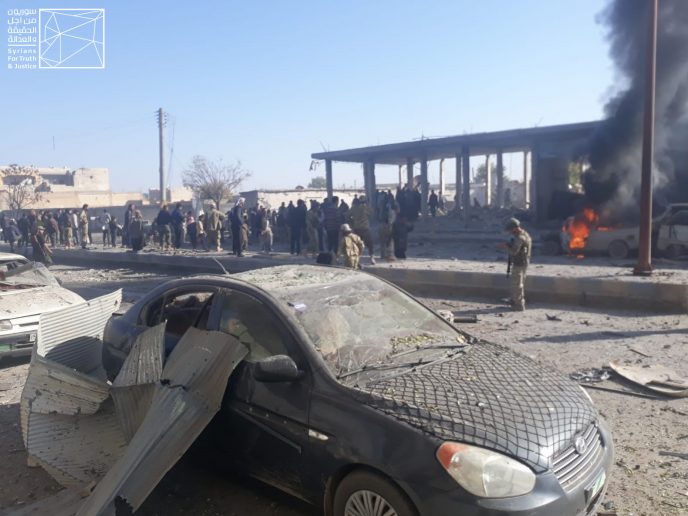
Image no. (1) – The location where the car bomb exploded, near the headquarters of the National Army-affiliated Third Legion’s command in the Industrial Area, Tell Abiad City, which took place on November 23, 2019. Photo credit: STJ.
2. On November 2, 2019, another car bomb exploded in the city’s main marketplace, particularly near a sweet shop called Ariha Sweets and close to the al-Ghanem Filling Station. The car below up between 3 and 4 p.m., causing the death of about 20 persons and the injury of many others. STJ’s field researcher managed to document the incident, obtain the testimonies of survivors and document the names of 15 dead people only, including 7 children and 3 women, as he offered condolence to the families of the victims. He pointed out that 5 of the dead remain so far unidentified.
Analysis of visual evidence: The image below shows the location of the blast, which hit the center of Tell Abiad City’s market place, the damage that befell the shops and the remains of the car bomb.
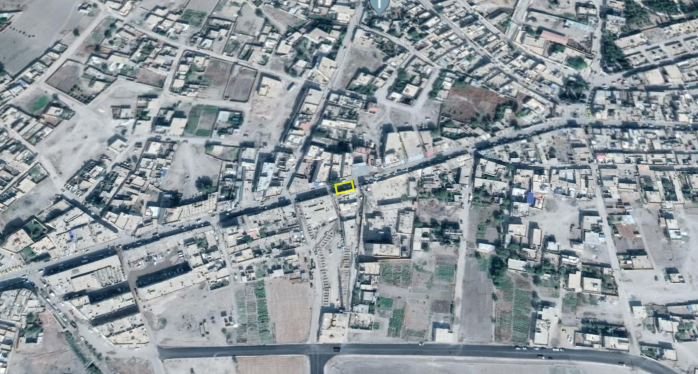
Image no. (2) – The satellite image shows the place where the car bomb blew up in the main street in Tell Abiad City/the Market Street. The blast’s site is marked in yellow.
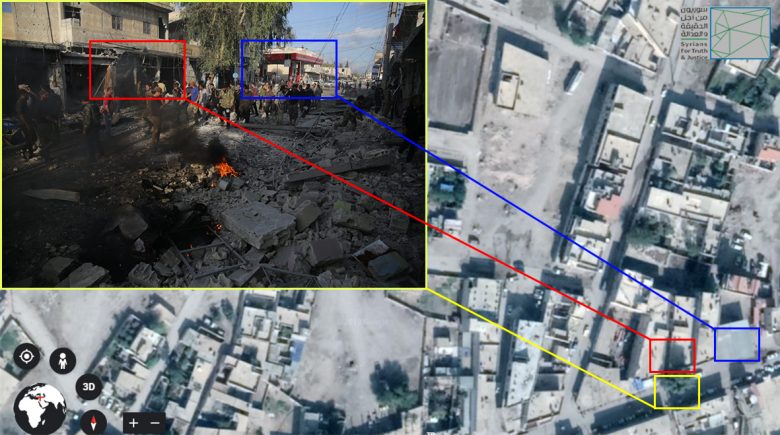
Image no. (3) – The location of the explosion, where the al-Ghanem Filling Station appears in blue, Ariha Sweets appears in red and the angle from which the image was taken is in yellow, indicating the explosion’s site. Photo credit: STJ.
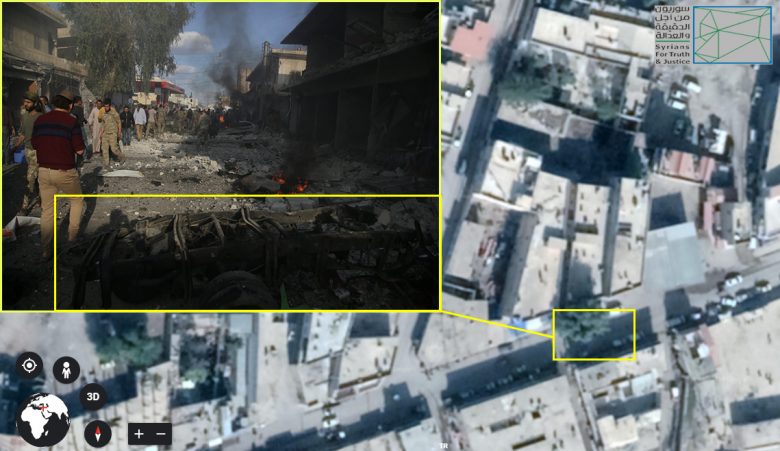
Image no. (4) – In the upper corner to the left, a yellow box marks the remains of the car bomb. The map in the background, however, indicates the location of the blast. Photo credit: STJ.
STJ’s field researcher met three of the blast survivors, who gave an account of the incident. Khalil A., The first witness to speak, narrated the following:
“I was at a foodstuff shop, from where I intended to buy a few items for home. I heard an ear deafening noise and could see nothing around me. There was a thick curtain of dust and smoke. I began calling the shop’s owner, his name is Aboud, but had no answer at all. I was almost blind; I saw nothing and the stuff around the shop were falling over me while I dragged myself on the floor. I wanted to leave the shop to have a breath, for I was suffocating with massive amounts of dust, the smell of gunpowder and smoke formed by combustion. I first thought that it was something inside the shop that blew up, but it never came to my mind that a car bomb was detonated outside. Coming out of the shop, I saw people running all over the place; the cars were damaged and motorcycles on fire. Women were wailing, so were the children. I could only perceive cars loaded with injured and dead people, being rushed to the hospital. I also had a car, which I borrowed from a friend, type Van. I thought that I could use it to transport the injured; however, when I approached it, I saw how destroyed it was, with its ceiling folded up by the force of the explosion.”
The second witness, named A. H., told STJ’s field researcher that the explosion took place 50 kilometers far from the shop where he works. He added:
“When the explosion took place, I noticed that it happened close to the shop where my paternal cousin works. I searched for him and knew that he was hospitalized, for he was burned. He died in Turkey affected by the injuries in his back and face. Other two staffers, who worked in the same shop, also died.”
The third witness, named Mohammad al-Ahmad, said:
“I was about 300 meters away from the explosion’s site. I was standing with a friend and heard a piercing sound. I immediately could tell that it was a car bomb. At that moment, what came to my mind was my two sisters who were at the market to buy some necessities. I charged towards the explosion despite those who called me not to go there. I did not even look back; I was certain that a catastrophe has happened. Praised be God, my sisters were of the first people who showed up; I asked them to go home immediately. I went closer to the blast’s site; the cars were on fire, so were the motorcycles. The destruction that befell the buildings was massive. In the area, there were more than 20 shops, which were all extremely affected; you could see through the holes in the walls. There was also a two-story-building, the second floor’s houses had lost all their front walls. A washing machine, dandling from a rooftop, also fell down, giving a strong crashing sound that people thought it was another blast.”
Concerning the nature of the blast and the substances used, STJ’s field researcher interviewed a military source in the city of Tell Abiad. Refusing to reveal his name, the source said that the car bomb was remote-controlled, adding:
“The detonated car was a Kia 2700. By examining the shrapnel and the remains of the car, we came to know that the explosive substance used is TNT with pellets — small and round pieces of steel. This kind of ammunition is used to cause severe damage, for it spreads so fast like shrapnel.”
3. On November 5, 2019, STJ’s field researcher quoted several of the al-Jabha al-Shamiyah/Levant Front’s militants as saying that one of the armed group’s militants, stationed near the al-Anbarji Buildings, saw a man, accompanied by a woman and a child, parking a red Kia Rio near the shops and down the building turned into a post for the armed group. The militants asked the man to remove the car, but the latter refused saying that he had a flat tire. The man, woman and the child went on their way, and it was only 15 minutes later that the car blew up. While no casualties were recorded, the explosion caused partial damage to the shops on the street. According to the militants, the armed group managed to arrest the man, the woman and the child at the al-Siasiah Roundabout’s checkpoint. The destiny of the three, however, is yet unknown.
4. On October 24, 2019, a car bomb blew up near the building of the old Cultural Center, seized by the Filaq al-Majd/Glory Brigade and turned into a military post. Two civilian men died in the explosion as they crossed the street. However, none of the targeted armed group’s militants were injured.
Having controlled the city, STJ’s field researcher said, the armed opposition groups set up three checkpoints in Tell Abiad —one near the al-Siasiah Roundabout, another near the al-Jalab River, 300 kilometers away from Tell Abiad and a third to the west of the city’s entrance, at the road leading to the Tall Abiad Sharqi Village. Surveillance and guards, nonetheless, were limited to the doors and the entrances to the buildings turned by the two armed groups into military headquarters, including the residential buildings they seized, such as those of al-Anbarji, the Teacher Syndicate and the School Dispensary, referred to as Dar al-Shuhada/House of Martyrs during the reign of the Autonomous Administration.
Following the explosion on November 2, 2019, the militants of the two armed groups started blocking the main roads and setting up checkpoints and inspection posts at the al-Qafas/ Ali ibn Abi Talib Mosque Roundabout, denying cars entry into the city’s main market. The al-Jabha al-Shamiyah/Levant Front has also deployed several militants to prevent cars from entering the market. Its militants erected another checkpoint near the municipality building and closed the opposite end of the road, which leads to the market, as well, using dust and sand filled bags.
2. Security Conditions and Blasts in Slouk Town:
The Ahrar al-Sharqiya, as the armed group’s official Twitter account indicates, has taken over the town of Slouk on October 13, 2019, following clashes with the Syrian Democratic Forces/SDF.
Once inside the town, the armed group erected checkpoints at the entrances to the area and following the explosions it blocked the side roads leading to the city’s marketplace, allowing neither cars nor motorcycles in. STJ’s field researcher succeeded in monitoring the procedures followed by the armed group, which resorted to machinery belonging to the municipality to block the side roads.
Commenting on the healthcare reality in the city, STJ’s filed researcher said that there is only one medical post, which a single doctor and a single male nurse run for a specific number of hours. The medical post lacks ambulances, forcing people to use their own cars or the vehicles belonging to the armed group to transport the wounded to Turkey. The process of hospitalization, the researcher pointed out, is random and is regulated by no coordination efforts.
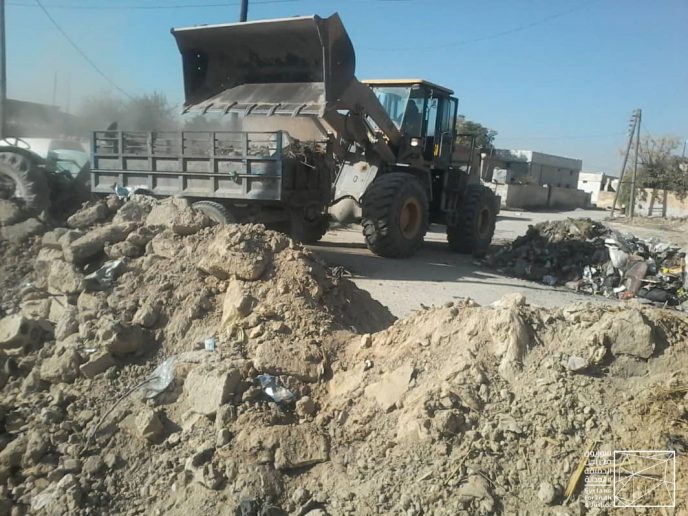 Image no. (5) – The blockage of the side roads leading to the main market in Slouk Town, Raqqa Province. Taken on November 20, 2019. Photo credit: STJ.
Image no. (5) – The blockage of the side roads leading to the main market in Slouk Town, Raqqa Province. Taken on November 20, 2019. Photo credit: STJ.
In October 2019, the Slouk Town was hit by three blasts and suffered a fourth in November 2019. On its official Twitter account, the Ahrar al-Sharqiya published an account covering the explosion, as follows:
1. Slouk Town’s Marketplace Blast on November 10, 2019, a truck, type Antar, was detonated near a roundabout on the main road in Slouk Town, particularly close to a bakery. STJ managed to view the content of a video taken from a surveillance camera, fixed at a distance from the explosion’s site, which still showed the moment the blast kicked off. STJ’s field researcher also met two eyewitnesses who survived the blast. Both men said:
“The detonated car belongs to a man called Khlaif, who got killed in the explosion. The two witnesses quoted a relative of Khlaif, as saying that he was detained in the city of Raqqa for 15 days before he returned to the Slouk Town and pulled his car over near the roundabout. The car then exploded.”
One of the witnesses added that khlaif was standing next to his car, speaking to a man called M. Sh., before the bomb went on and both were dead.
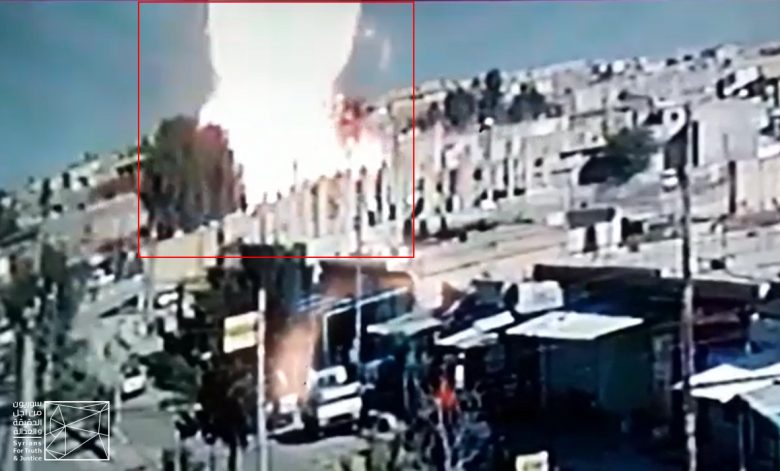
Image no. (6) – The footage is taken from a surveillance camera, showing the first seconds of the exploration that hit the main market in Slouk Town on November 10, 2019. STJ obtained the video from a private source.
Commenting on how the blast took place, a military source told STJ’s field researcher the following:
“The car was detonated using a device that locates the car and sets the bomb on remotely. It was a big Antar vehicle — a Hyundai truck used for shipping. The explosive substance was fixed to the doors, the front panel, the bonnet and other hidden places. In the majority of the blasts, the explosive substance was located in the front part of the car because the rear part of it is usually less liable to damage. We do not often find remains of the frontal carcass of the car, but we regularly find pieces of its rear part, such as the bumper and large parts of the boot.”
Analysis of visual evidence: The image below shows the location of the blast and the destruction it effected, given that STJ’s researcher visited the site almost a week after the explosion.
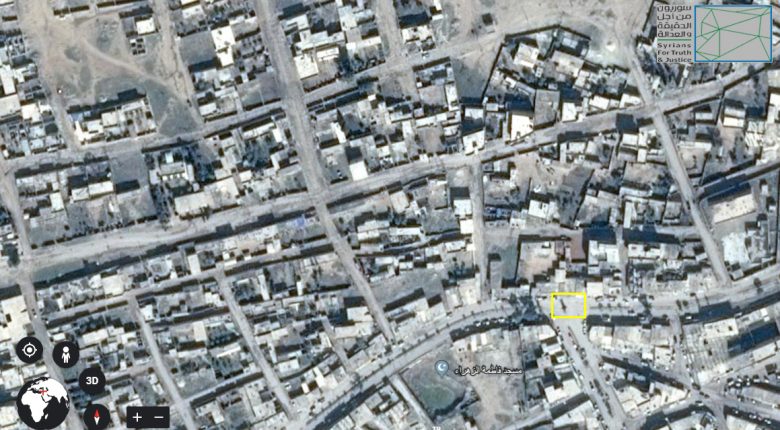
Image no. (7) – The general location of the explosion that took place on the main street in Slouk Town on November 10, 2019.
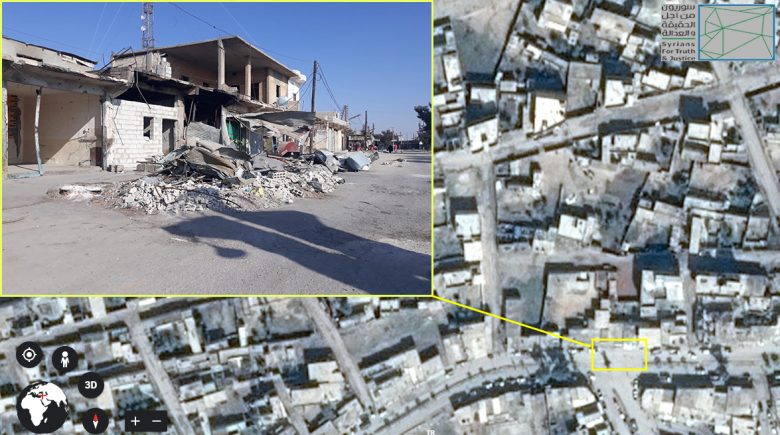
Image no. (8) – In the upper corner to the left, there is the bakery, near which the blast took place, given that the wall of the bakery has been recently renovated, in addition to rubble and the damaged shops near the bakery. The image in the background is of the bakery’s location in Slouk Town.
On the same note, STJ’s field searcher interviewed a medical staffer, who said that the blast caused the death of seven persons, including militants of the National Army, in addition to dozens of injured. The researcher also met three of the blast survivors, who recounted what they bore witness to.
Commenting on the incident, Abu Mohammad, a medical staffer at Slouk Hospital, said:
“The injured were rushed to the hospital immediately after the explosion. Seven persons died on the spot, including two militants of the National Army, three children and two men. The number then rose to eight, for another man died after arriving into the hospital. We failed to address the severe wounds; all we could do was to bandage the injuries, stop the bleeding and provide the people with a drip and then send them to Turkey onboard the vehicles of the National Army, as there are no ambulances in the area. The number of the injured amounted to 25 persons on the day of the bombing. The next day, others sought us to remove a small shrapnel or stitch a little wound.”
One of the bakery’s workers, H. N., recounted to STJ what happened on the explosion’s day:
“Just before the blast took place, I left the bakery, leaving my son there to sell bread. I only reached the shop on the opposite side of the road when the car exploded. I fell to the ground. I looked in the direction of the blast and knew that it happened near the bakery, so I immediately ran to check on my son. The scene was tragic; there was massive destruction at the square, and the bakery’s wall had turned into rubble. I searched for my son under the debris, a few stones have fallen over him. His leg was bleeding, so I held him up and took him to the hospital, for a shrapnel has rested in his leg. The area was in utter destruction, and several of my neighbors died, including the owner of a secondhand-cloth shop, named Hussain al-Sarmudi. He used to work at the shop opposite to the bakery. There were walls within the bakery; they were all wrecked. The bakery was out of service, and it took us a week to renovate the damage.”
The father of one of the children who bore witness to the blast said:
“I was at home, and I heard a strong sound. I expected that it was a car bomb, but I did not think of going out. My wife, then, told me that my son had already went to the market. I rushed to the explosion’s site. Arriving in there, I saw them removing the dead bodies, some of which were charred. I counted seven bodies while the wounded came on the street and asked for help. The vehicles of the National Army were transporting them to the Slouk Hospital. I did not just linger there; I was approaching the wounded, looking for my son. I even searched for him among the dead. I wandered among the debris while smoke and dust yet covered the place. I looked inside the tailor’s shop where my son was supposed to go. I saw him hiding behind the counter, unharmed. The shop’s glass window was all smashed, and the glass shrapnel were around the place. However, praised be God, no one in the shop was hurt.”
2. Blasts in October:
- On October 26, 2019, the Ahrar al-Sharqiya announced being targeted with an improvised explosive device, which caused the injury of several militants. On the same day, without mentioning further details, it declared dismantling another explosive device.
- On October 28, 2019, the armed group stated that a car bomb blew up on the major street in Slouk Town, taking a toll on a person and injuring another five, without mentioning additional details, as well.
- On October 23, 2019, a car bomb kicked off on the main market in Slouk Town, rendering two persons dead and injuring seven others, including children.
On Twitter, the Ahrar al-Sharqiya posted two videos, showing the injured being hospitalized, in addition to a photo of the blast’s location and a list with the affected people’s names, two dead children, Sadam Khalil al-Mousa, 13 years old, and Mohammad Yassin al-Sayah, 12 years old, and seven injured persons, two of whom were children, too.

